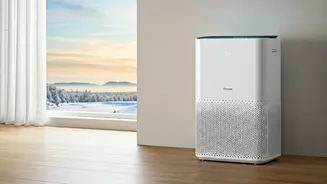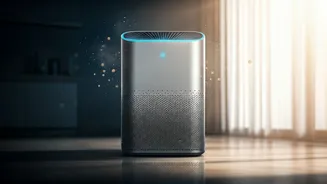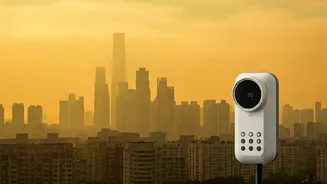Smart Air Purifiers
Air purifiers are essential for eliminating pollutants and allergens from indoor air. Modern smart air purifiers go beyond basic filtration, offering features
that enhance their effectiveness and convenience. These devices typically feature multiple filtration stages, including pre-filters to capture larger particles like dust and pet dander, HEPA filters to trap smaller pollutants like smoke and pollen, and activated carbon filters to absorb odors and volatile organic compounds (VOCs). Smart purifiers often integrate with mobile apps, allowing users to monitor air quality levels, adjust settings remotely, and receive alerts when filters need replacement. Some models even feature automatic modes that adjust fan speed based on real-time air quality readings. Consider options with quiet operation modes for bedrooms and living areas to minimize disruption. These appliances are designed to improve indoor air quality by trapping pollutants and allergens.
Smart Air Quality Sensors
Understanding the air quality inside your home is the first step towards managing it. Smart air quality sensors provide real-time data on various pollutants. These sensors measure particulate matter (PM2.5 and PM10), which includes fine particles from vehicle emissions and construction, as well as harmful gases like carbon dioxide (CO2), and volatile organic compounds (VOCs). These sensors connect to your home Wi-Fi network and transmit data to a user-friendly app on your smartphone. The app displays air quality readings and provides insights into the types of pollutants present. Many sensors offer historical data, allowing you to track air quality trends and identify potential pollution sources. Some sensors can also integrate with smart home systems, triggering actions like turning on air purifiers or opening windows when pollution levels rise. The devices will help provide you with knowledge to make informed decisions.
Smart Air Conditioners
Air conditioners are indispensable in Delhi's climate, but their impact on indoor air quality can be significant. Smart air conditioners offer advanced features designed to improve air quality. They often incorporate built-in air filters to remove dust and other particles. The filters can be easily cleaned or replaced, maintaining optimal performance. Smart ACs can also be controlled via a smartphone app, allowing you to adjust settings remotely, such as fan speed and temperature. Some models include sensors that detect air quality levels and automatically adjust the air conditioning settings to maintain a healthy indoor environment. For example, they may increase the fan speed to circulate the air or activate the air purification mode. This can significantly improve the air quality inside your home while providing cooling comfort.
Smart Humidifiers & Dehumidifiers
Maintaining optimal humidity levels is crucial for both comfort and health, particularly during Delhi's varying seasons. Smart humidifiers and dehumidifiers help regulate moisture, improving indoor air quality. Smart humidifiers monitor humidity levels and automatically add moisture to the air when it's too dry. This helps prevent dry skin, irritated sinuses, and other issues associated with low humidity. Smart dehumidifiers, on the other hand, remove excess moisture, preventing mold and mildew growth, which can trigger allergies and respiratory problems. Both types of devices often feature smart controls, allowing you to set desired humidity levels, schedule operation times, and monitor performance via a smartphone app. Some models even integrate with other smart home devices, such as air purifiers, to maintain a balanced and healthy indoor environment. These help maintain a balance for the environment.
Smart Ventilation Systems
Proper ventilation is crucial for removing stale air and pollutants from your home. Smart ventilation systems offer efficient and controlled air exchange. These systems often include features such as energy recovery ventilators (ERVs) or heat recovery ventilators (HRVs). ERVs and HRVs exchange stale indoor air with fresh outdoor air while recovering energy, which reduces energy consumption. Smart ventilation systems can be controlled automatically, adjusting airflow based on air quality sensor readings. They can also be integrated with smart home systems to ensure optimal ventilation. Some systems include air filters to remove outdoor pollutants before they enter the home, further improving indoor air quality. These systems are crucial for maintaining a healthy living environment, providing fresh air circulation.
Smart Window Openers
Opening windows is a natural way to ventilate your home, but it can be challenging to manage, especially with Delhi's pollution. Smart window openers automate this process, offering convenience and control. These devices typically attach to your windows and connect to your smart home system. You can set schedules for opening and closing windows, or you can trigger them remotely using a smartphone app. Smart window openers can integrate with air quality sensors, automatically closing windows when pollution levels rise. This prevents outdoor pollutants from entering your home. This is helpful when you are not at home. Some systems may include rain sensors, which automatically close windows when it rains. The smart openers allow you to manage your home's ventilation effectively.
Smart Home Assistants
Smart home assistants such as Amazon Echo or Google Home can be integrated with many of the smart home gadgets to control your home. Smart home assistants can act as a central hub, controlling other smart home devices. You can use voice commands to manage your air purifier, adjust the temperature on your smart air conditioner, or check the air quality readings from your smart sensor. These assistants can also provide useful information about outdoor air quality and offer recommendations for improving indoor air quality based on your home's environment. Additionally, you can set up routines to automate various tasks, such as turning on your air purifier at a certain time or closing the windows when pollution levels are high. Integrating a smart home assistant provides a convenient way to manage your indoor environment.
Smart Air Quality Monitors
Smart air quality monitors are designed to provide comprehensive air quality information. Unlike basic sensors, these monitors often measure a wider range of pollutants, including particulate matter, VOCs, carbon dioxide, and even ozone. The smart monitors typically have larger displays that showcase real-time air quality data. These devices provide more detailed insights into the air quality in your home. Some models offer historical data tracking, allowing you to monitor trends and identify potential pollution sources. Smart air quality monitors can often connect to your Wi-Fi network, enabling you to access the data remotely through a smartphone app. Some monitors can also be integrated with other smart home devices, triggering automated actions like turning on air purifiers or adjusting ventilation systems. The extensive data the monitors supply will help to keep your home healthier.
Smart Home Automation Systems
Smart home automation systems provide a comprehensive way to manage all of your smart home gadgets. These systems integrate and coordinate the functions of various smart home devices, such as air purifiers, air conditioners, and ventilation systems. The systems can also connect to your home Wi-Fi network. They often include a central hub that connects to all your smart devices. You can create custom automation routines to control your home environment. For example, you can set up a routine that automatically turns on the air purifier, closes the windows, and adjusts the air conditioner when the air quality sensors detect high pollution levels. These systems also include a user-friendly interface that allows you to monitor and control all connected devices from a single app. This will simplify the overall management of your home.
DIY Air Quality Solutions
Besides investing in smart gadgets, there are a few DIY solutions you can utilize. Simple measures include regularly cleaning your home, dusting surfaces, and vacuuming frequently to remove dust and allergens. You can also use houseplants known for their air-purifying properties, like snake plants and spider plants, to help filter the air. Another DIY solution is to create your own air filter by combining a box fan with a high-efficiency particulate air (HEPA) filter. Place the HEPA filter on the back of the box fan to trap pollutants. This offers an affordable way to improve the air quality in a room. By implementing these easy solutions, you can enhance your indoor air quality. Along with the gadgets and home automation, you can create a healthy and fresh environment.













